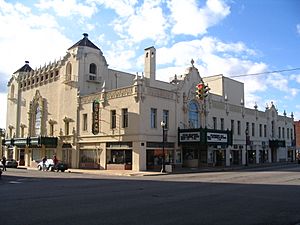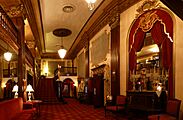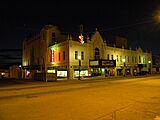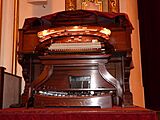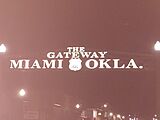Miami, Oklahoma facts for kids
Quick facts for kids
Miami, Oklahoma
|
|
|---|---|
|
City
|
|
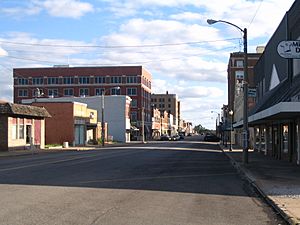
Downtown Miami (2008)
|
|
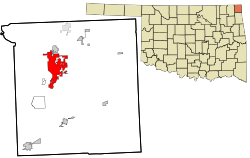
Location within Ottawa County and Oklahoma
|
|
| Country | United States |
| State | Oklahoma |
| County | Ottawa |
| Area | |
| • Total | 11.18 sq mi (28.96 km2) |
| • Land | 11.10 sq mi (28.74 km2) |
| • Water | 0.09 sq mi (0.22 km2) |
| Elevation | 778 ft (237 m) |
| Population
(2020)
|
|
| • Total | 12,969 |
| • Density | 1,168.80/sq mi (451.27/km2) |
| Time zone | UTC-6 (CST) |
| • Summer (DST) | UTC-5 (CDT) |
| ZIP code |
74354-74355
|
| Area code | 539/918 |
| FIPS code | 40-48000 |
| GNIS feature ID | 2411093 |
Miami (/maɪˈæmə/ my-AM-ə) is a city in Oklahoma, United States. It is the main city of Ottawa County. The city was started in 1891.
Long ago, people found lots of lead and zinc in the ground nearby. This helped the city grow very fast. Miami is also special because it is the capital city for several Native American tribes. These include the Miami Tribe of Oklahoma, the Modoc Tribe of Oklahoma, the Ottawa Tribe of Oklahoma, the Peoria Tribe of Indians, and the Shawnee Tribe. The city is named after the Miami Tribe. In 2020, about 12,969 people lived there.
Contents
A Look at Miami's Past
Miami was founded in a very planned way. Unlike some towns that just grew, Miami was carefully thought out. People with big ideas for the future helped create it.
In 1891, a man named W. C. Lykins asked the U.S. government to help start the town. He talked with Thomas F. Richardville, who was the chief of the Miami Tribe. They also met with the Ottawa Tribe.
The government then allowed them to buy land from the Ottawa Tribe. Lykins, Richardville, and Manford Pooler (the Ottawa chief) are known as the "fathers of Miami." Lykins' company bought about 588 acres of land. They sold pieces of land at an auction in June 1891. By 1895, Miami had over 800 people.
How Mining Helped Miami Grow
When a lot of lead and zinc was found nearby, Miami grew even faster. By 1907, when Oklahoma became a state, Miami had 1,893 people. As more mines opened, the population jumped to 6,802 by 1920.
Famous Roads Through Miami
Miami was on the Jefferson Highway, which was a very long road built in 1915. This road went over 2,300 miles from Canada all the way to New Orleans. The famous U.S. Route 66 also passed through Miami. You can still see a historic part of Route 66 in the city today.
Where is Miami Located?
Miami is located on the Neosho River. The city covers about 9.8 square miles of land. A small part, about 0.1 square miles, is water.
Dealing with Floods
Because it's on a river, Miami has had problems with floods. It was hit hard by a big flood in 1951. Since the 1990s, the town has flooded more than 24 times. The most recent big flood was in 2019.
Some people in Miami and nearby Native American groups are concerned about water levels. They believe that high water levels at a dam upstream can make flooding worse in Miami.
Who Lives in Miami?
| Historical population | |||
|---|---|---|---|
| Census | Pop. | %± | |
| 1900 | 1,527 | — | |
| 1910 | 2,907 | 90.4% | |
| 1920 | 6,802 | 134.0% | |
| 1930 | 8,064 | 18.6% | |
| 1940 | 8,345 | 3.5% | |
| 1950 | 11,801 | 41.4% | |
| 1960 | 12,869 | 9.1% | |
| 1970 | 13,880 | 7.9% | |
| 1980 | 14,237 | 2.6% | |
| 1990 | 13,142 | −7.7% | |
| 2000 | 13,704 | 4.3% | |
| 2010 | 13,570 | −1.0% | |
| 2020 | 12,969 | −4.4% | |
| Sources: | |||
In 2010, there were 13,570 people living in Miami. Most people were white (68.9%), and a large number were Native American (17.1%). About 8% of people were from two or more races.
About 24.7% of the people were under 18 years old. The average age was about 35.8 years.
How to Get Around Miami
Miami is easy to reach by car. It is located on Interstate 44 and U.S. Route 69. U.S. Route 59 is also very close.
There is a local bus service called Pelivan Transit. It offers a trolley loop in Miami and other bus services.
For air travel, Miami has the Miami Regional Airport. For bigger flights, people can go to Joplin Regional Airport or Tulsa International Airport.
Fun Places to Visit
Miami and the surrounding areas are popular for tourists. They are the third most visited place in Oklahoma, after Oklahoma City and Tulsa.
The Historic Coleman Theatre
One of the most famous places in Miami is the historic Coleman Theatre. It opened in 1929 as a fancy movie theater. It cost $600,000 to build, which was a lot of money back then!
The inside of the theater is very beautiful. It has gold decorations, silk panels, and stained glass. There's also a special Wurlitzer pipe organ. Today, the Coleman Theatre still shows movies and hosts live shows. A local group called the Miami Little Theatre puts on plays there every year. In 1983, the Coleman Theatre was added to the National Register of Historical Places.
Other Historic Buildings
Many other buildings in Miami are also on the National Register of Historical Places. These include the George L. Coleman Sr. House, the Miami Marathon Oil Company Service Station, and the Miami Downtown Historic District.
Learning and Schools
Most children in Miami go to schools run by the Miami Public Schools district. The high school is Miami High School. Their mascot is the Wardog, which is a very unique mascot! No other school in the United States uses it.
A small part of northern Miami is in the Commerce Public Schools district.
Northeastern Oklahoma A&M College is a local college. It started in 1925. Students can earn certificates or transfer to bigger universities to get four-year degrees. In 2015, about 2,000 students attended this college.
Famous People from Miami
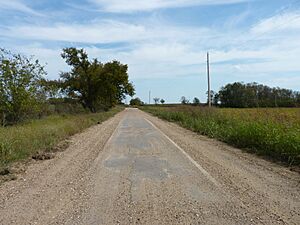
Many interesting people have come from Miami, Oklahoma:
- Keith Anderson – a musician
- Lucien Ballard – a director of photography
- David Froman – an actor
- Cassie Gaines – a singer
- Steve Gaines – a musician
- Moscelyne Larkin – a ballerina
- Carol Littleton – a film editor
- Mackenzie McKee – a reality TV personality
- Charles R. Nesbitt – a public servant
- Steve Owens – won the Heisman Trophy in 1969 for football
- Don Porter – an actor
- Moriss Taylor – a singer and TV host
- Keifer Thompson – a musician
- Charles Banks Wilson – an artist
- Glad Robinson Youse – a composer
Images for kids
See also
 In Spanish: Miami (Oklahoma) para niños
In Spanish: Miami (Oklahoma) para niños


